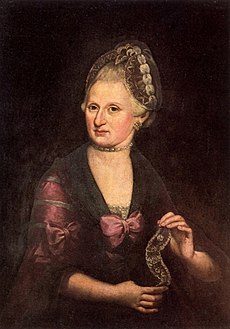Berthilde von Freudenberg
Berthilde Heilwig von Freudenberg | |
|---|---|
 Berthilde Heilwig von Freudenberg circa 1775 | |
| Born | 15 November 1720 |
| Died | 3 July 1778 |
| Resting place | St. Hildegard Cemetery, Köln |
| Nationality | Nidwaldeser |
| Known for | One of the greatest Astyrian composers |
Berthilde Heilwig von Freudenberg (15 November 1720 – 3 July 1778) known as was a Nidwaldeser writer, composer and pianist. She is remembered as one of the greatest composers of all time, with her works having marked the course of classical music in Lorecia during the 18th century.
Born in 1720 in the city of Köln, Nidwalden, Freudenberg's talent and virtuous capacity to write and compose were rapidly seen by her parents, who at an early age, took her to attend piano classes. As an intelectually gifted girl, with 17 years, Freudenberg took advantage of the socially progressive Nidwaldeser society, and skipped two years to attend the Hildegard University, where she developed some of her first complete pieces under the tutelage of Egilhard Grosf and Adelheid von Dreierg. During her stay in Hildegard, Freudenberg also took several courses about letters and humanities, developing certain attraction to poetry. About her years in the university, few is known and most of it comes from letters that she exchanged with her parents, specially her mother, to which she used to tell about her incursion in the arts and the social circles of the town. With 19 years, before leaving Hildegard, Freudenberg published her Opus 1, which rapidly gained the attention of Willem van Hardenbroek, Noordenstaater aristocrat that courted Berthilde in Koninstad, where she she moved with 19 years.
In Koninstad, she composed her first Symphony that was published in 1740 and was dedicated to van Hardenbroek; her works continued throughout her stance in the city before she returned to Nidwalden and was commissioned by the Church of Nidwalden to compose several pieces. During this time, Freudenberg lived in the Scholoss Haugette, which became an usual scenario of her poems; Alberich von Bradforde would write in 1748 that "life in the Nidwaldeser countryside inspired Berthilde to create her most special pieces", even though Bradforde notes that it was during this time that Freudenberg was going to start feeling a "personal and interior" pain. Modern psychologists attribute this period to an episode of depression lived by Berthilde; she often found relief in the modest St. Matthias parish that was close to her home.
In 1767, Freudenberg returned to Noordenstaat, where she spent her last years composing the latest symphonies, chamber music and piano sonatas. In the city, Berthilde assisted to several bars and got immersed in a bohemian circle that allowed her to discover new styles and her own sexuality. In 1778, Freudenberg died and was accompanied until her last moment by Elfrun De Vend, who was known as her closest friend and suspected girlfriend. Her funeral was attended by thousands and included state honours by the King of Noordenstaat-Scanonia. Her remains were left in the cemetery of Koninstad until 1927, when she was moved to the St. Hildegard Cemetery in Köln.